Pas de Bourrée is one of the basic steps of dance and one of the first that you will learn in your ballet class. The pas de bourrée is an auxiliary and connecting movement used to work in the centre of the room, in the adagio and in the jumps, to move in different directions. You always start by studying the pas de bourrée at the bar and then move on to the centre. In this article, we are going to explain the variants of the Pas de Bourrée of the Vaganova School.
Table of Contents
What key elements should be considered when executing a pas de bourrée?
Although this step can be done in different ways, you should think about some key elements. Almost all pas de bourrée are made up of three beats: the first with knees bent and the other two with knees straight.
On the other hand, you should add the movements of your arms, wrists and head. Also, be careful to stretch your feet well when you are doing the cou de pied.
The outstanding characteristic of the pas de bourrée is that in its execution, the feet are always raised in half-point or point. That is, the heels reach the ground only at the end of the entire movement.

Why is it called pas de bourrée?
Unlike most words in the ballet vocabulary where the meaning of the word, usually in French, is directly related to the movement, the Pas de Bourrée is a movement that is not related to its literal meaning. In French, bourrée means drunk or stuffed, nothing to do with movement. Actually, it is said that it comes from a popular dance from the French region of Auvergne. It is believed that La Bourrée was introduced to the court of Paris in the 17th century. And from there, it would be introduced to ballet classes.
How many pas de bourrée are there?
There are two main types of pas de bourrée: with a change of leg and without a change of leg. In the first case, if you start with the right leg, at the end of the movement the left leg will be forward. In the second case, the right remains. All these movements can be done in different directions: forwards, backwards, croisé, efface or ecarté. All variations of the pas de bourrée can be made en tournant.
Pas de Bourrée changing the feet

1) Get into croisé in the fifth position with the left leg behind. Put your arms into bras-bras position.
2) Make a demi plie with the right leg. At the same time, place the left foot en cou de pied behind the right leg.
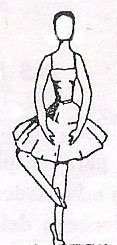
3) Place your left foot on the floor in relevé in half-point (demi-pointe). You should keep your left leg fully stretched. Simultaneously, put the right leg in front of the left leg in cou de pied.
(1st beat)

4) Support the right foot on relevé in half-point (demi-pointe). The right leg must be well stretched. At the same time bring the left foot in cou de pied in front of the right leg
(2nd beat)

5) Finally, land with the weight of your body on the left leg in demi plie and the right leg behind in cou de pied. Your left leg should be in front of your right leg. Finally, your arms remain in a bras-bras position and the body in croisé. Repeat the same, starting with the other leg.
(3rd beat)
Learn the basic positions and movements here:
If you’re a very beginner, you can find more information about the cou de pied here.
Pas de Bourrée without changing feet

1) Get into croisé in the fifth position with the left leg behind. Place your arms into bras-bras position.
2) Make a demi plie with the right leg. At the same time, place the left foot en cou de pied behind the right leg.
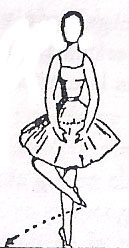
3) Support the left foot on the floor in relevé in half-point (demi-pointe). You should keep your left leg fully stretched. Simultaneously, put the right leg in front of the left leg in cou de pied.
With a move to the right, place your right leg on relevé in half-point (demi-pointe).
(1st beat)

4) The right leg must be well stretched. At the same time bring the left foot in cou de pied behind the right leg.
(2nd beat)

5) Finally, land with the weight of your body on the left leg in demi plie. At the same time, open your right leg in the second position at the height of 45°. Open your arms in the second position. To continue the step, bring your right leg back to the left. Place it in relevé, at the same time that your left foot is in cou de pied and so on. Your left leg will always be behind your right leg. (3rd beat)
Pas de Bourreé Dessus

1) Get into croisé in the fifth position with the left leg behind. Place your arms into bras-bras position
2) Make a demi plie with the right leg. At the same time, place the left foot en cou de pied behind the right leg.
3) Open your left leg in the second position at the height of 45°.

4) Then, bring back your left leg to the right side. Place your left leg in relevé, in front of your right leg. At the same time, put your right foot in cou de pied behind your left leg.
(1st beat)
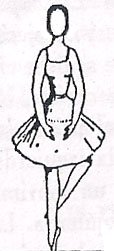
5) With a move to the right, put your right leg on relevé in half-point (demi-pointe). Your right leg should be completely stretched. At the same time bring your left foot in cou de pied behind the right leg.
(2nd beat)

6) Land on your left leg in demi plie, taking your weight on it. At the same time, open your right leg in the second position at the height of 45°. Repeat all movement to the other side.
(3rd beat)
Pas de Bourrée en tournant en dedans

1) Get into the fifth position with the left leg behind.
2) Make a demi plie with the right leg. Simultaneously, put the left foot en cou de pied behind your right leg.
3) Open your left leg in the second position at the height of 45°.

4) Bring your left leg into a half turn to the right and at the same time stretch your right leg out in relevé. You will be on your back.
5) Immediately after finishing the half twist, place your right foot en cou de pied in front of your left leg.
(1st beat)

6) Finish a complete turn to the right, landing your right leg in relevé and placing your left foot in cou de pied behind.
(2nd beat)

7) Finally, land with your left leg in demi plie and your right leg in front in cou de pied.
(3rd beat)
Pas de Bourrée en tournant en dehors.

1) Make a demi plie with the left leg. At the same time, place the right foot en cou de pied in front of the left leg.
2) Open your right leg in the second position at the height of 45°.
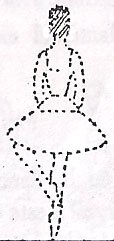
3) Then place your right leg in relevé, doing a half turn to the right. You will be on your back.
3) Immediately after finishing the half twist, place your left foot en cou de pied behind your right leg.
(1st beat)

4) Finish a complete turn to the right, landing your left leg in relevé and placing your right foot in cou de pied in front of your left leg.
(2nd beat)

5) Finally, land with your right leg in demi plie and your left leg behind in cou de pied.
(3rd beat)






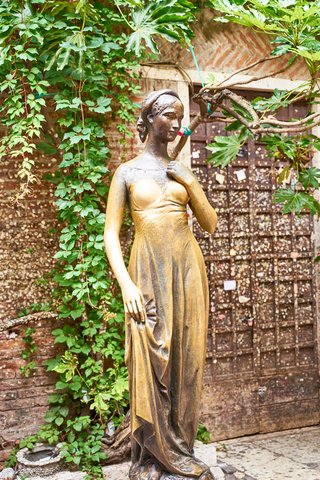
Leave a Reply